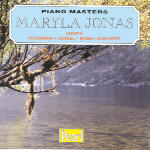Specialist piano collectors occasionally stumble upon a rare Columbia LP containing Chopin mazurkas played by one Maryla Jonas. As Jonathan Dobson’s booklet notes point out, the Polish-born pianist studied with such luminaries as Igance Jan Paderewski and Emil von Sauer. Her career, however, was thwarted by the 1939 Nazi invasion of her native country, which had a devastating effect on the pianist in both mind and body. Eventually she made it to the Americas, capped by her New York debut recital in February, 1946. One reviewer called Jonas “the finest woman pianist since Teresa Carreño”. Conversely, B. H. Haggin, in The Nation, offered less charitable comments. The truth lies between both extremes. In the aforementioned Chopin mazurkas, Jonas casts a wispy but ever-present shadow as she deftly skates across the music’s surface. You won’t find anything like Ignaz Friedman’s propulsive, soaring bass lines or Artur Rubinstein’s lithe spontaneity (I speak of his 1930s recordings). Instead, Jonas focuses attention on the melodies, pointing up their beauties by way of long-limbed rubatos. Her breathless demeanor may strike some listeners as glib and superficial, yet the playing holds your attention.
Salon-like charm dominates the Op. 70 D-flat and G-flat waltzes and early B-flat Polonaise, along with the E minor Op. 72 and youthful C-sharp minor Nocturnes. Schumann’s Kinderszenen features much pretty playing but lacks the coloristic variety and lyric eloquence that typifies 78-era Kinderszenens from Alfred Cortot, Fanny Davies, and Yves Nat. More unstylish delights close the collection in the form of Handel’s G minor Passacaglia, Rossi’s Andantino in C, and a little Schubert waltz medley. Jonas plays Schubert’s G-flat impromptu using the once fashionable G major transposition with bowdlerized harmonies. My dog-eared LP copy of Mazurkas, by the way, is less noisy and fuller in body than Roger Beardsley’s transfers from 78 rpm pressings. Beardsley’s added reverb is not to my taste, but at least he faithfully reproduces Jonas’ sonority as originally engineered.
































